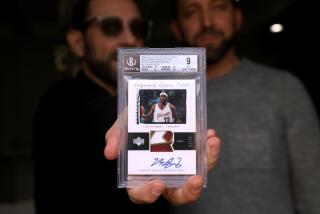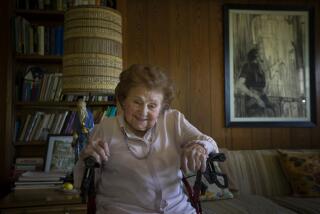Calling On the Past
Gerald Burg opens a catalog and points to a card bearing the signature of Mordecai “Three Finger” Brown, a baseball legend who pitched in the early 1900s. At age 7, Brown lopped off a finger in his uncle’s corn shredder. A couple weeks later, he broke two more fingers while chasing a hog.
The resulting deformities did not affect his work in the coal mines, but once he became a pitcher, the odd configuration of his grip resulted in a curve ball that baffled hitters and earned him a place in the Hall of Fame.
Opening bid for the card: $350.
The feeling of holding such a piece of history has fueled Burg’s hunger since he was a youngster growing up in Detroit. At age 76, he owns what may be the world’s largest collection of calling cards. Included are cards imprinted with some of the most famous names in history: Thomas Jefferson, Adolf Hitler, Sitting Bull, Napoleon.
Earlier this year, he decided to sell the collection. In January, he retired after working more than 50 years in the Jewish community. His last two positions were that of executive director of Wilshire Boulevard Temple and Sinai Temple, both in Los Angeles.
“The Hitler card I did not buy,” Burg says. The card, along with other German documents, was discovered by a friend during World War II. After he died, the man’s wife discovered the documents. She contacted Burg, who notified a friend at the Pentagon.
“He said, ‘We’re not interested in that stuff,’ so I showed her how to slowly release them to the auction houses so she wouldn’t dilute the field. She realized a quarter-million dollars and gifted me with the Hitler card.”)
Burg and his wife, Flavia, a retired social worker, have been living off Social Security. They have some small investments, and they have children who would provide them with financial support if they needed it.
Burg says it is not out of financial desperation that he is selling the collection. He is selling it out of love.
“I want Flavia to be taken care of if something should happen to me,” he says, “and I want other people to be able to enjoy the collection as much as I have.”
On June 24-25, Burg’s collection will be auctioned by Ira & Larry Goldberg Coins & Collectibles in Beverly Hills. The sale, of more than 10,000 cards, is billed as the most substantial such collection ever offered.
“It’s been a part of me for a long, long time, and it’s with sadness that I part with it,” he says. “The truth of the matter is I would love to be in a position where I could donate it to a public library, if they would make it available to whomever wanted to look at it, but I’m not in that position. I can’t afford to do that. It turns out to be my pension fund.”
Burg has never viewed the collection in terms of its monetary value, always keeping a dozen or so cards in his pocket to show people.
“People would always ask him if he was worried that he might lose them,” Flavia says, “but he never worried about that.”
The joy of having the cards, Burg says, is being able to share them, not locking them away. He hopes that whoever the buyers are, they will make the cards accessible to the public.
As he ponders the card of Mordecai Brown, he muses about bidding on it himself, then closes the catalog.
“I guess it would be silly now,” he says.
*
“Hey, Freddie,” Burg calls out to the man in the wheelchair. “How ya doin’? I got some cookies for ya.”
Three days a week, four hours at a time, Burg comes to the Valley Dialysis Center in Van Nuys for treatment. He sometimes shares another passion--magic--with the staff, performing card tricks or making things disappear. He knows people by name and brings gifts for their children.
Freddie wheels over to Burg in the waiting room and slyly unveils cookies of his own.
“Take a bite of this,” he dares Burg, handing him a wafer sandwiched around a paper-thin layer of chocolate. The transaction is executed gently as if they were handling a butterfly. Burg studies the cookie, places it on his tongue then bites down gently.
“Ooh,” he says. “I think I’m going to have an organism.”
There is sincere joy in their laughter.
In 1997, when his kidneys failed, Burg almost died. Doctors told his family they should say goodbye, and say it soon. Burg cried as he asked his son, screenwriter Andrew Burg, to care for Flavia as he braced for death.
But slowly he recovered, and ever since, the laughter has felt better and the cookies have tasted sweeter.
Burg’s first lesson in mortality came at a young age. When he was 8, his father died during gall bladder surgery. His mother supported the three children by selling coal from door to door before finding work as a department store clerk.
To help his mother, Burg hawked newspapers, finishing high school in night classes. His passion for calling cards began at age 15, when he wrote to the Library of Congress expressing his desire to “hold history in my hands.”
A woman wrote back referring him to Mary Benjamin, whose father owned a manuscript business in New York. He wrote to Benjamin, making note of his weekly allowance of 25 cents.
Benjamin sent him a shoe box containing scraps of papers, some of them signatures of local dignitaries cut from letters. Burg thought it was desecration to remove them from the letters, but then he saw a dozen or so calling cards, each of them marked on the back with prices from 50 cents to $2.50.
He kept a few, returned the rest, and they settled on a payment plan. Benjamin also wrote to other collectors informing them of Burg’s interest, and soon Burg began receiving catalogs and newsletters. One by one, his collection grew.
After graduating from high school, Burg went to work for U.S. Rubber and transferred to Los Angeles in the mid-1940s. In 1945, he became youth director of B’nai B’rith. Throughout his life, he has worked, largely behind the scenes, for numerous civic organizations, helping govern and raise money. For two years, he served as president of the board of Didi Hirsch Community Mental Health Services.
Through it all, his collection grew.
*
The practice of calling cards, sometimes referred to as visiting cards, goes back centuries and flourished during the Victorian period, when they also were known as visiting cards. They were offered as formal introduction of guests and visitors, sometimes left in silver trays set out in entry ways.
There was a code: If the upper right corner was folded, it meant someone had visited in person. Finding an unfolded card in the tray meant that a servant had made delivery. A folded upper left corner offered congratulations, while the lower left corner represented condolences, or a way of saying goodbye. Some people had special sympathy calling cards, which were bordered in black.
One of Burg’s cards has an especially unusual marking, a bullet hole in the upper right corner. It is dated Feb. 18, 1918. Imprinted on the card is the name Mrs. Frank E. Butler. In parentheses is the name for which she was more widely known, Annie Oakley.
It is accompanied by a letter from the recipient of the card, who describes to a friend the meeting with Oakley.
“Her husband held the card, and she shot a hole in the corner and she signed it,” the letter states. It is signed R.R.
“It’s very provocative material,” says Jonathan Sachs, cataloger and researcher for the auction house, as he pores over the collection, searching for context and meaning of the oftentimes cryptic messages. “You can research a lot of it, but a lot of it is enigmatic. We’ll never know.”
He cites a note penned by Russian-born composer Igor Stravinsky. Some of the words are difficult to read, he says, but this is his interpretation: “Dear Mr. Stevens, please tell me, where did you hear my Chant Funebre. This piece was never published, and I considered it as lost somewhere in Russia during the first world war and the Communist Revolution. I shall appreciate your answer. Sincerely yours, I. Stravinsky, May 17, 1943.”
It appears, says Sachs, that Stravinsky was contacted by someone who had written to express admiration of the piece, written in 1908. One is left to wonder, says Sachs: Who was Mr. Stevens? Had he actually heard the piece performed? What was his reply?
Another card is imprinted with the name of the Randall House, which is described as being “for the accommodation of all who visit the most pleasant military post of the frontier. Although in Indian Country, this post is strongly garrisoned and safe from danger. Tourists and others will find it a pleasant place to visit.”
On the back of the card is the bold signature of Sitting Bull. The Randall House, Sachs says, is where the legendary leader was held prisoner.
“There’s a beautiful, signed quote by Andre Malraux, the French novelist and aesthetician,” he says. “The quote is, ‘It can’t be that the highest purpose of art is to give consciousness to the man that ignores the greatest in himself.’ Then it’s signed and dated.”
There are cards of Hemingway and London, Mark Twain, Hawthorne. The most Burg paid for a card was $3,000 for a Thomas Jefferson, one of three such signed cards known to exist, he says. In all, Burg has spent about $150,000 on his collection.
“It’s absolutely fascinating,” Sachs says. “This is by far the most massive collection I’ve come across. I know for a fact that . . . never before has there ever been a collection of this size and magnitude on the market.”
Not all the cards are being sold, Burg says. Some he will keep. Their value, he says, is more sentimental than monetary.
There’s one from a Playboy bunny.
“Forty-six inches,” he notes.
There’s one from Mel Blanc, the voice of Bugs Bunny, who wrote, “Eh, what’s up, Gerry?” There’s another from Steven Spielberg’s mom signed “Steven Spielberg’s mom.”
For Burg, it’s somewhat of an addiction. As little sense as it makes, he admits he decided to put in a bid for that Mordecai Brown card.
“My wife asked me why I did that since I’m selling the collection,” he says. “I told her I didn’t know. I guess I just don’t want the hunt to be over. You can’t change a love. It doesn’t turn into something else.”
Nor does it merely disappear. Unlike his collection, love cannot be bought or sold. The feeling of holding history in his hands will continue to be held in his heart; and that, more than money, will see him through.
*
Duane Noriyuki can be reached at duane.noriyuki@latimes.com.
More to Read
Sign up for The Wild
We’ll help you find the best places to hike, bike and run, as well as the perfect silent spots for meditation and yoga.
You may occasionally receive promotional content from the Los Angeles Times.






